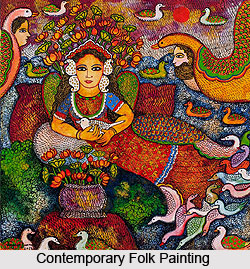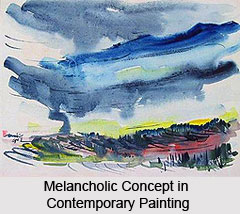 Contemporary concepts of Indian art articulate diverse subjects and emotions in a unique yet prominent manner. Indian art encompasses paintings, sculptures, collages, assemblages and installations, each of which is uniquely proficient in depicting varied themes. In contemporary times artists have worked out intriguing concepts which reflect their thoughts explicitly. Many of these have found inspirations from the global art. Notions and perceptions of artists regarding life and global issues find magnificent expressions through different themes. These innovative concepts of art that have emerged in this era through constant experimentations have earned a worldwide recognition to the artists and have secured an admired place for them in the global arena. Contemporary concepts have made significant contribution in making Indian art a dynamic one by diversifying the mediums of expressions. These concepts are highly potent in portraying latest themes and ideas.
Contemporary concepts of Indian art articulate diverse subjects and emotions in a unique yet prominent manner. Indian art encompasses paintings, sculptures, collages, assemblages and installations, each of which is uniquely proficient in depicting varied themes. In contemporary times artists have worked out intriguing concepts which reflect their thoughts explicitly. Many of these have found inspirations from the global art. Notions and perceptions of artists regarding life and global issues find magnificent expressions through different themes. These innovative concepts of art that have emerged in this era through constant experimentations have earned a worldwide recognition to the artists and have secured an admired place for them in the global arena. Contemporary concepts have made significant contribution in making Indian art a dynamic one by diversifying the mediums of expressions. These concepts are highly potent in portraying latest themes and ideas.
Melancholic Concept in Indian Art
Melancholic concepts are the intriguing depictions of loneliness in human life. Glum of life dominate such creations. This concept was most evident in the works of Nikhil Biswas, an acclaimed Indian painter.
Folk Concept in Indian Art
Folk concept is one of the most popular concepts of Indian art characterized by elaborate motifs and designs. This concept mirrors the folk life of India through lively creations. Cheerful women, lush environment and other facets of Indian villages reflect beautifully through folk concepts of Indian art. Jayasri Burman and J. Sultan Ali are the best known painters to weave the expressions of rural India in an exquisite manner.
 Colossal Concept in Indian Art
Colossal Concept in Indian Art
Colossal concept in Indian art comprise of huge paintings and sculptures portraying different facets of urban life. The arts which focus on this theme have dominant figuration. The sculptures and paintings of Ramachandran echo colossal themes encompassing varied emotions.
Calligraphic Concept in Indian Arts
Calligraphy is another dominant concept in Indian art. The works of Laxman Shreshtha articulate this concept beautifully in his paintings.
Amalgamation Concept in Indian Art
Ragamala paintings are the best examples of amalgamation art which portray a fine blend of poetry, art and classical music. These are fundamentally based on raagas which are personified by moods and colours, depicting different tales.
Apart form these, Indian art covers a vast array of concepts which includes social, political and economic scenarios. Through contemporary concepts, Indian art has attained new heights, setting new trends and styles for the artists. Innate ideas of various artists have led to the evolution of these concepts which often depict layered meanings. They have essentially helped the Indian art to unleash the shackles of traditional styles and craft new ones that enhances expressions and meanings.



















